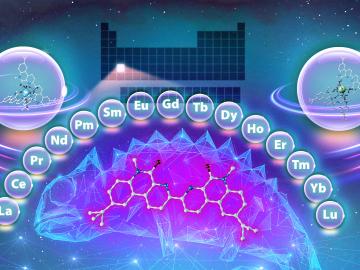
Filter News
Area of Research
- Advanced Manufacturing (6)
- Biology and Environment (21)
- Biology and Soft Matter (1)
- Computational Biology (1)
- Computational Engineering (1)
- Computer Science (1)
- Electricity and Smart Grid (1)
- Energy Science (50)
- Functional Materials for Energy (1)
- Fusion and Fission (8)
- Fusion Energy (2)
- Isotope Development and Production (1)
- Isotopes (2)
- Materials (125)
- Materials Characterization (1)
- Materials for Computing (19)
- Materials Under Extremes (1)
- Mathematics (1)
- National Security (7)
- Neutron Science (124)
- Nuclear Science and Technology (8)
- Supercomputing (31)
- Transportation Systems (1)
News Topics
- (-) Chemical Sciences (86)
- (-) Materials Science (158)
- (-) Mathematics (12)
- (-) Neutron Science (171)
- 3-D Printing/Advanced Manufacturing (146)
- Advanced Reactors (40)
- Artificial Intelligence (131)
- Big Data (79)
- Bioenergy (112)
- Biology (128)
- Biomedical (73)
- Biotechnology (39)
- Buildings (74)
- Clean Water (33)
- Composites (35)
- Computer Science (226)
- Coronavirus (48)
- Critical Materials (29)
- Cybersecurity (35)
- Education (5)
- Element Discovery (1)
- Emergency (4)
- Energy Storage (114)
- Environment (218)
- Exascale Computing (67)
- Fossil Energy (8)
- Frontier (64)
- Fusion (66)
- Grid (74)
- High-Performance Computing (130)
- Hydropower (12)
- Irradiation (3)
- Isotopes (62)
- ITER (9)
- Machine Learning (68)
- Materials (157)
- Mercury (12)
- Microelectronics (4)
- Microscopy (56)
- Molten Salt (10)
- Nanotechnology (64)
- National Security (86)
- Nuclear Energy (122)
- Partnerships (68)
- Physics (69)
- Polymers (35)
- Quantum Computing (53)
- Quantum Science (92)
- Security (31)
- Simulation (65)
- Software (1)
- Space Exploration (26)
- Statistics (4)
- Summit (71)
- Transportation (103)
Media Contacts

Oak Ridge National Laboratory has launched its Neutron Nexus pilot program with Florida Agricultural & Mechanical University and Florida State University through the FAMU-FSU College of Engineering. The first program of its kind nationwide, it’s aimed at broadening and diversifying the scientific user community with outreach to universities and colleges.

Scientists at ORNL used neutrons to end a decades-long debate about an enzyme cancer uses.

A study led by the Department of Energy’s Oak Ridge National Laboratory details how artificial intelligence researchers created an AI model to help identify new alloys used as shielding for housing fusion applications components in a nuclear reactor. The findings mark a major step towards improving nuclear fusion facilities.

ORNL's Spallation Neutron Source, the nation’s leading source of pulsed neutron beams for research, was recently restarted after nine months of upgrade work.

Daryl Yang is coupling his science and engineering expertise to devise new ways to measure significant changes going on in the Arctic, a region that’s warming nearly four times faster than other parts of the planet. The remote sensing technologies and modeling tools he develops and leverages for the Next-Generation Ecosystem Experiments in the Arctic project, or NGEE Arctic, help improve models of the ecosystem to better inform decision-making as the landscape changes.

Distinguished materials scientist Takeshi Egami has spent his career revealing the complex atomic structure of metallic glass and other liquids — sometimes sharing theories with initially resistant minds in the scientific community.

ORNL’s Matthew Loyd will receive a Department of Energy Office of Science Early Career Research award.

Using LEGO® bricks, Robert Saethre has worked to create a model of the ring injection region of the SNS pulsed accelerator that features the new Proton Power Upgrade magnets and vacuum chambers.

Researchers at the Department of Energy’s Oak Ridge National Laboratory have found a chemical “chameleon” that could improve the process used to purify rare-earth metals used in clean energy, medical and national security applications.

A team led by scientists at ORNL identified and demonstrated a method to process a plant-based material called nanocellulose that reduced energy needs by a whopping 21%, using simulations on the lab’s supercomputers and follow-on analysis.


